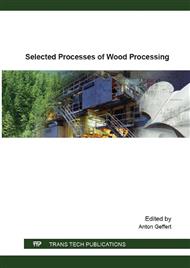[1]
C. Pereira, F. Caldeira Jorge, J. M. F. Ferreira, Adsorption of cations from a cement suspension onto lignocellulosic substrates and its influence on cement setting, Journal of Wood Chemistry and Technology. 25 (2005) 231–244.
DOI: 10.1080/02773810500366672
Google Scholar
[2]
M. Nazerian, M. D. Ghalehno, E. Gozali, Effects of wood species, particle sizes and dimensions of residue obtained from trimming of wood–cement composites on physical and mechanical properties of cement-bonded particleboard, Wood Material Science and Engineering. 6 (2011).
DOI: 10.1080/17480272.2011.601816
Google Scholar
[3]
A. A. Klyosov, Wood–Plastic Composites, Wiley, Hoboken, NJ, USA, (2007).
Google Scholar
[4]
X. F. Sun, R. C. Sun, J. Tomkinson, M. S. Baird, Degradation of wheat straw lignin and hemicellulosic polymers by a totally chlorine-free method, Polym. Degrad. Stab. 83 (2004) 47–57.
DOI: 10.1016/s0141-3910(03)00205-2
Google Scholar
[5]
B. F. Tjeerdsma, H. Militz, Chemical changes in hydrothermal treated wood: FT-IR analysis of combined hydrothermal and dry heat-treated wood, Holz Roh-Werkstoff. 63 (2005) 102–111.
DOI: 10.1007/s00107-004-0532-8
Google Scholar
[6]
E.Y. Razumov, R.R. Safin, S.Š. Barcík, M. Kvietková, K.R. Romelevich, Studies on mechanical properties of composite materials based on thermo modified timber, Drvna Industrija. 64-1 (2013) 3-8.
DOI: 10.5552/drind.2013.1206
Google Scholar
[7]
W. -P. Chang, K. -J. Kim, Rakesh K. Gupta, Moisture Absorption Behavior of Wood/Plastic Composites Made with Ultrasound-Assisted Alkali-Treated Wood Particulates, Composite Interfaces. 16 (2009) 937–951.
DOI: 10.1163/092764409x12477481859067
Google Scholar
[8]
W. -P. Chang, Ultrasound-Assisted Surface Modification of Wood Particulates for Improved Wood/Plastic Composites, M.S. thesis, Department of Chemical Engineering, West Virginia University, Morgantown, WV, USA (2008).
DOI: 10.33915/etd.1903
Google Scholar
[9]
H. B. Sowbhagya, V. N. Chitra, Enzyme-Assisted Extraction of Flavorings and Colorants from Plant Materials, Critical Reviews in Food Science and Nutrition. 50 (2010) 146–161.
DOI: 10.1080/10408390802248775
Google Scholar
[10]
C. Skear, Water in Wood, Syracuse University Press, USA, 1972, p.28–31.
Google Scholar
[11]
M. Nazerian, M. D. Ghalehno, E. Gozali, Effects of wood species, particle sizes and dimensions of residue obtained from trimming of wood-cement composites on physical and mechanical properties of cement-bonded particleboard, Wood Material Science and Engineering. 6 (2011).
DOI: 10.1080/17480272.2011.601816
Google Scholar


